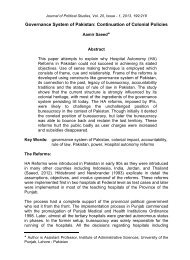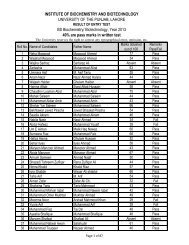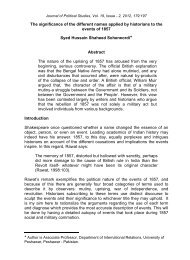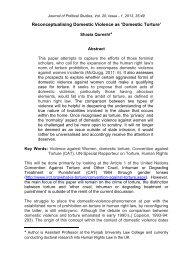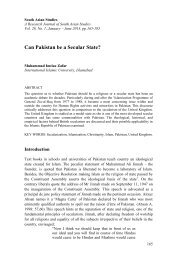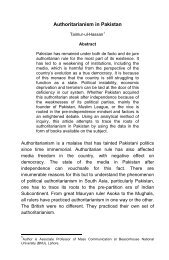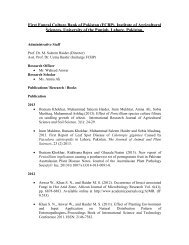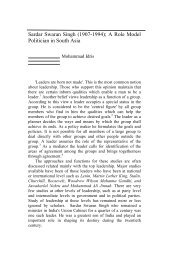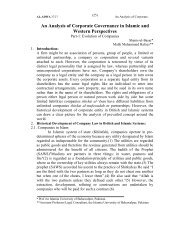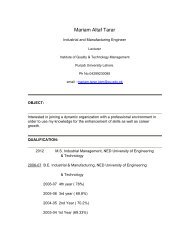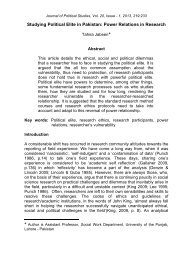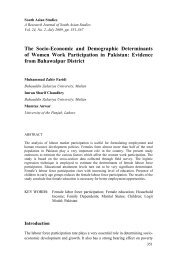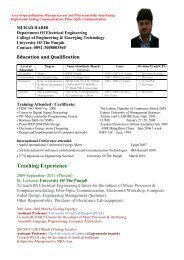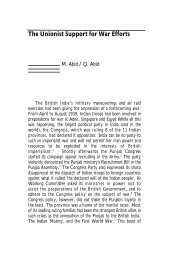pakistan geographical review 1954 - University of the Punjab
pakistan geographical review 1954 - University of the Punjab
pakistan geographical review 1954 - University of the Punjab
You also want an ePaper? Increase the reach of your titles
YUMPU automatically turns print PDFs into web optimized ePapers that Google loves.
and Kar achi. Before <strong>the</strong> opening <strong>of</strong> <strong>the</strong> railway line and <strong>the</strong> construction <strong>of</strong><br />
<strong>the</strong> Lansdown Bridge many steamers and boats used to ply on <strong>the</strong> river and<br />
<strong>the</strong> town was <strong>the</strong> chief inland river port for traffic by <strong>the</strong> Indus Steam Flotilla<br />
and native boats between <strong>the</strong> <strong>Punjab</strong> and Sind. After <strong>the</strong> construction <strong>of</strong><br />
bridges, although <strong>the</strong> river traffic has diminished considerably, <strong>the</strong> prosperity<br />
and commercial importance <strong>of</strong> <strong>the</strong> town still mainly depends upon its river<br />
traffic with <strong>the</strong> <strong>Punjab</strong>. Even today, a large number <strong>of</strong> country crafts are used<br />
for this purpose.<br />
Wheat is <strong>the</strong> most important commodity which is brought for transaction<br />
in this 'rnandi '. The greater bulk <strong>of</strong> <strong>the</strong> crop produced in Upper Sind is<br />
brought to this town ei<strong>the</strong>r by rail or by road and river. For road and rail<br />
borne traffic Sukkur is <strong>the</strong> natural market for <strong>the</strong> Upper part <strong>of</strong> <strong>the</strong> lower<br />
Indus Basin as it is connected by metalled roads with Larkaaa , <strong>the</strong> Upper<br />
Sind and <strong>the</strong> Sukkur Districts. For this reason most <strong>of</strong> <strong>the</strong> crops harvested<br />
in <strong>the</strong> Sukkur and Upper Sind districts are stored first at Sukkur and <strong>the</strong>n<br />
transported by rail to o<strong>the</strong>r parts.<br />
Besides <strong>the</strong> agricultural products, 'deodar' woodis an imported commodity<br />
which is floated down <strong>the</strong> river in great bulk from <strong>the</strong> <strong>Punjab</strong>. A considerable<br />
quantity <strong>of</strong> it is consumed locally.<br />
INDUSTRIES<br />
Little can be said about <strong>the</strong> industrial aspect <strong>of</strong> <strong>the</strong> town in <strong>the</strong> past<br />
except that only cottage industries were established at that time. The common<br />
indispensible artisans found in <strong>the</strong> town were <strong>the</strong> black-smiths, shoe makers,<br />
carpenters, jewellers, weavers and potters. The skilled carpenters, weavers and<br />
jewellers turned out excellent articles for practical use. There were, and still<br />
are, workers in fine arts for which Sind has been noted for a long period. The<br />
woollen and silken goods are worth mentioning. Even today cottage work is<br />
being carried on in several parts <strong>of</strong> <strong>the</strong> town. Hand loom cloth, rope, shoes,<br />
wooden articles and jewellery are products which are worth noting.<br />
For <strong>the</strong> first time in <strong>the</strong> industrial history <strong>of</strong> this town, in <strong>the</strong> year<br />
1890-1 <strong>the</strong> Central Government <strong>of</strong> India set up a railway work-shop at Sukkur,<br />
which provided jobs for about 500 people. In <strong>the</strong> year 1906, a small scale<br />
cotton ginning factory was set up and in <strong>the</strong> year 1911-12 a flour mill was<br />
located at Sukkur, which could employ about 70 persons. In <strong>the</strong> year 1915,<br />
a set <strong>of</strong> rice husking hullers and an ice plant were opened in <strong>the</strong> town. In <strong>the</strong><br />
56



